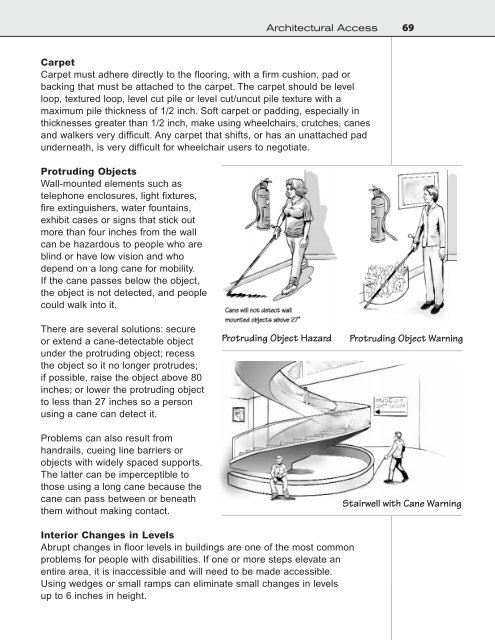Design for Accessibility: A Cultural Administrator's Handbook
Design for Accessibility: A Cultural Administrator's Handbook
Design for Accessibility: A Cultural Administrator's Handbook
Create successful ePaper yourself
Turn your PDF publications into a flip-book with our unique Google optimized e-Paper software.
Architectural Access<br />
69<br />
Carpet<br />
Carpet must adhere directly to the flooring, with a firm cushion, pad or<br />
backing that must be attached to the carpet. The carpet should be level<br />
loop, textured loop, level cut pile or level cut/uncut pile texture with a<br />
maximum pile thickness of 1/2 inch. Soft carpet or padding, especially in<br />
thicknesses greater than 1/2 inch, make using wheelchairs, crutches, canes<br />
and walkers very difficult. Any carpet that shifts, or has an unattached pad<br />
underneath, is very difficult <strong>for</strong> wheelchair users to negotiate.<br />
Protruding Objects<br />
Wall-mounted elements such as<br />
telephone enclosures, light fixtures,<br />
fire extinguishers, water fountains,<br />
exhibit cases or signs that stick out<br />
more than four inches from the wall<br />
can be hazardous to people who are<br />
blind or have low vision and who<br />
depend on a long cane <strong>for</strong> mobility.<br />
If the cane passes below the object,<br />
the object is not detected, and people<br />
could walk into it.<br />
There are several solutions: secure<br />
or extend a cane-detectable object<br />
under the protruding object; recess<br />
the object so it no longer protrudes;<br />
if possible, raise the object above 80<br />
inches; or lower the protruding object<br />
to less than 27 inches so a person<br />
using a cane can detect it.<br />
Problems can also result from<br />
handrails, cueing line barriers or<br />
objects with widely spaced supports.<br />
The latter can be imperceptible to<br />
those using a long cane because the<br />
cane can pass between or beneath<br />
them without making contact.<br />
Protruding Object Hazard<br />
Protruding Object Warning<br />
Stairwell with Cane Warning<br />
Interior Changes in Levels<br />
Abrupt changes in floor levels in buildings are one of the most common<br />
problems <strong>for</strong> people with disabilities. If one or more steps elevate an<br />
entire area, it is inaccessible and will need to be made accessible.<br />
Using wedges or small ramps can eliminate small changes in levels<br />
up to 6 inches in height.


